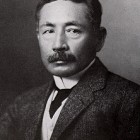
Нацумэ Сосэки — библиография
- 41 произведение
- 55 изданий на 8 языках
Произведения
-
Sanşiro Нацумэ Сосэки
Форма: роман Оригинальное название: 三四郎 / Sanshirō Дата написания: 1908 РазвернутьSanşiro, benim en sevdiğim kitaplardan biri. —Haruki Murakami Modern Japon romanının en ?nemli temsilcilerinden Natsume Sōseki’nin ince mizah ve sonsuz masumiyetle ?r?l? bu romanı, 23 yaşındaki Sanşiro’nun yaşadığı k???k yerden ayrılıp ?niversite i?in Tokyo’ya gitmesiyle başlıyor. Şehrin kalabalığı, yeni insanlar, akademik ?evreler ve hepsinden ?nemlisi kadınlar arasında Sanşiro, yaşamını zenginleştirmenin yollarını arıyor. Sanşiro, ilk aşk, gelenekler, modernleşme ve yaşlılığın alaycılığına karşı gen?liğin idealizmini anlatırken, arka planda da d?nemin sosyal ve k?lt?rel yapısına getirdiği eleştirileri okuruna sunuyor. Ondan fazla roman…
-
Кокоро Нацумэ Сосэки
Форма: роман Оригинальное название: こゝろ (Kokoro) Дата написания: 1914 Первая публикация: 2022 Перевод: Екатерина Рябова РазвернутьРоман 1914 года Нацумэ Сосэки «Кокоро» заслуженно считается одним из лучших в современной японской литературе. По объемам продаж этот роман стал самой продаваемой книгой Японии. Роман о японской интеллигенции, о трагедии в сердце человека, о кризисе окружающего мира и катастрофе внутреннего. Эпиграфом к роману стала фраза китайского философа: «Сердце — властитель человеческого существа». Кокоро – мужской роман. Женские персонажи хоть и появляются, без них бы история о любви была невозможна, но центральные персонажи — безымянные мужчины, живущие на стыке эпох Мэйдзи и Тайсё. Роман из 110 глав, публиковавшийся в газете «Асахисимбун»,…
-
Soy un gato Нацумэ Сосэки
Форма: роман Оригинальное название: 吾輩は猫である (Wagahai wa Neko dearu) Дата написания: 1905 Развернуть"Soy un gato, aunque todav?a no tengo nombre". As? comienza la primera y m?s hilarante novela de Natsume Soseki, una aut?ntica obra maestra de la literatura japonesa, que narra las aventuras de un desde?oso felino que cohabita, de modo accidental, con un grupo de grotescos personajes, miembros todos ellos de la bienpensante clase media tokiota: el disp?ptico profesor Kushami y su familia, te?ricos due?os de la casa donde vive el gato; el mejor amigo del profesor, el charlat?n e irritante Meitei; o el joven estudioso Kangetsu, que d?a s?, d?a no, intenta arregl?rselas para conquistar a la hija de los vecinos. Escrita justo antes de su…
-
Kokoro Нацумэ Сосэки
Форма: роман Оригинальное название: こゝろ (Kokoro) Дата написания: 1914 РазвернутьLiterally meaning “heart”, the Japanese word “kokoro” can be more distinctly translated as “the heart of things” or “feeling.” Natsume Soseki’s 1914 novel, which was originally published in serial format in a Japanese newspaper, “Kokoro” deals with the transition from the Japanese Meiji society to the modern era. Divided into three parts “Sensei and I,” “My Parents and I,” and “Sensei and His Testament,” the novel explores the themes of loneliness and isolation. In the first part we find the narrator attending university where he befriends an older man, known only as “Sensei,” who lives a largely reclusive life. In the second part of the…
-
Spring Miscellany Нацумэ СосэкиРазвернуть
For the first time, English readers have access to Soseki’s Spring Miscellany . Originally published as Eijitu Shohin in serial form in the Asahi newspaper in 1909, before appearing in book form, Spring Miscellany is an pastiche of twenty-five sketches, referred to as shohin (little items), heir to the great zuihitsu tradition of discursive prose. These personal vignettes are clearly autobiographical and reveal Soseki’s kaleidoscopic view of his private world and his interest in authentic, unadorned self-expression.The stories range from from episodes from his youth to his adult musings. Of special interest are the accounts of Soseki’s…
-
Inside My Glass Doors Нацумэ СосэкиРазвернуть
Originally published as Garusudo no Uchi in daily serialization in the Asahi newspaper in 1915, before appearing in book form, this is the first time Inside My Glass Doors has been published in English. It is a moving literary reminiscence, a collection of thirty-nine autobiographical essays penned a year before the author's death. Written in the genre of shohin (little items), the personal vignettes provide a kaleidoscopic view of Natsume Soseki's private world and shed light on his concerns as a novelist.Readers are at once ushered into Soseki's book-lined study, in his residence in Kikui-cho, as he muses on his present situation and…
-
Sanshiro Natsume Sōseki
Форма: роман Оригинальное название: 三四郎 / Sanshirō Дата написания: 1908 Первая публикация: 1908 -
Heredity of Taste Нацумэ СосэкиРазвернуть
Written in eight days, in December 1905, and published in the January 1906 issue of the magazine Teikoku Bungaku (Imperial Literature), Shumi no iden (The Heredity of Taste) is Soseki Natsume's only anti-war work. Chronicling the mourning process of a narrator haunted by his friend's death, the story reveals Soseki's attitude to the atrocity of war, specifically to the Russo-Japanese War of 1904-5, and to the personal tragedies and loss of individuality of young men like his hero Ko-san, and the sacrifices made by both the living and the dead.Although the first part of the story powerfully describes the narrator's visions of the war dead,…
-
And Then Нацумэ Сосэки
Форма: роман Оригинальное название: それから (Sorekara) Дата написания: 1909 РазвернутьDaisuke, the protagonist, is a man in his twenties who is struggling with his personal purpose and identity as well as the changing social landscape of Meiji-era Japan. As Japan enters the Twentieth Century, ancient customs give way to western ideals, and Daisuke works to resolve his feelings of disconnection and abandonment during this time of change. Thanks to his father's wealth, Daisuke has the luxury of having time to develop his philosophies and ruminate on their meaning while remaining intellectually aloof from traditional Japanese culture and the demands of growing industrialization. Then Daisuke's life takes an unexpected turn when…
-
My Individualism and the Philosophical Foundations of Litera Нацумэ СосэкиРазвернуть
Published here for the first time in English, My Individualism and The Philosophical Foundations of Literature are essays which explore issues close to famed Japanese novelist Soseki Natsume's heart: the philosophical and cultural significance of isolation, belonging and identity associated with rapid technological, industrial and cultural change. Set against the background of the Meiji era, in which Soseki believed modern man was dislocated from Japan's past as well as its future, he defines the role of art and the artist in light of the loneliness and individualism of the modern world.True to his self-conscious style, each essay includes…
-
210th Day Нацумэ СосэкиРазвернуть
First published as Nihyaku Toka in 1906, The 210th Day is published here for the first time in English. Focusing on two strongly contrasting characters, Kei and Roku, as they attempt to climb the rumbling Mount Aso as it threatens to erupt, it is a celebration of personal experience and subjective reaction to an event in the author's life. During their progress up the mountain—where they encounter a storm on the 210th day (the lunar calendar day traditionally associated with typhoons)—and during a stopover at an inn along the way, Roku, the main protagonist, banters with Kei about his background, behavior and his reaction to the things they…
-
Ваш покорный слуга кот Нацумэ Сосэки
Форма: роман Оригинальное название: 吾輩は猫である (Wagahai wa Neko dearu) Дата написания: 1905 Первая публикация: 1960 Перевод: Аркадий Стругацкий, Л. Коршиков РазвернутьНаслушавшись в доме своего хозяина умных разговоров о новых течениях современной мысли, в первую очередь о модном индивидуализме и о "сверхчеловеке", кот возомнил себя существом необыкновенным, подлинным "сыном двадцатого века". Комизм ситуации, как в "Путешествиях Гулливера" Свифта, состоит в том, что карлик меряет великана меркой своего малого мира с полным чувством собственного превосходства. Хозяин кажется коту "придурковатым", выходки, чудачества хозяина - верх нелепости. Карлик не владеет ключом к душе великана. Но это верно только в том случае, если существо из малого "кошачьего" мирка встречается с подлинно большим человеком. "Не…
-
Light and Dark Natsume Sōseki
Форма: роман Оригинальное название: 明暗 (Meian) Дата написания: 1916 Перевод: John Nathan РазвернутьLight and Dark, Natsume Soseki's longest novel and masterpiece, although unfinished, is a minutely observed study of haute-bourgeois manners on the eve of World War I. It is also a psychological portrait of a new marriage that achieves a depth and exactitude of character revelation that had no precedent in Japan at the time of its publication and has not been equaled since. With Light and Dark, Soseki invented the modern Japanese novel. Recovering in a clinic following surgery, thirty-year-old Tsuda Yoshio receives visits from a procession of intimates: his coquettish young wife, O-Nobu; his unsparing younger sister, O-Hide, who blames…
-
Grass On The Wayside Soseki Natsume
Форма: роман Оригинальное название: 道草 (Michikusa) Дата написания: 1915 Перевод: Edwin McClellan This novel touches on Sōseki's personal experiences and his resentment towards life. The main points in this novel portrayed his own personality deteriorating, and his feeling of wanting love and acceptance, but at the same time rejecting it because he does not want to feel betrayed by those he loves.
-
Изголовье из трав Нацумэ Сосэки
Форма: повесть Оригинальное название: 草枕 (Kusamakura) Дата написания: 1906 Перевод: М. Русяева, Н. Спиридонова, Т. Соколова-Делюсина



















